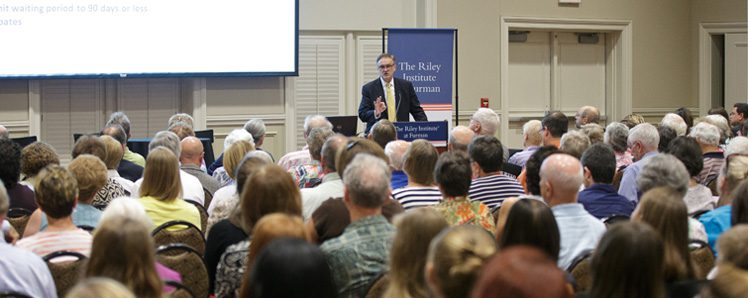
The new building had a major impact on membership growth, Kennedy said, with improved parking, space for more and larger classes, and increased social opportunities such as card games and special interest groups. Just 4 percent of members are minorities, and Kennedy added, “We’re working on that,” with presentations to groups with large minorities memberships. Ages of participants range 55-101 the largest cohort being 55-74. A 2016 survey of members showed a profile of a geographically diverse group: 46 percent of members had moved here within the past 9 years. This year is the 25 th anniversary of the founding of FULIR, now OLLI. “It is very important for Furman to have a presence in the community.” “There may be a day when we have more OLLI members than Furman students,” said OLLI Director Nancy Kennedy, who took over direction of the OLLI program from Lucy Woodhouse in 2014. Since 2012, when OLLI moved into its new home, membership more than doubled, to 2,350 from 1,200. Several major gifts followed, including a “significant gift” from Furman trustee Gordon Herring that earned him naming rights for the new Herring Center. As, membership climbed to 1,100, OLLI members raised $3 million. A $6 million, 22,000 square foot facility was conceived. In 2009, membership reached 500 and FULIR became the Osher Lifelong Learning Institute at Furman, or OLLI.Īs enrollment in OLLI soared, the leadership faced the realization that the program would need more, preferably its own, space. In 2008, FULIR received the first installment of what would grow to a $1 million endowment from the Bernard Osher Foundation, securing operational funding for the program’s future. In 1993, it offered seven classes to 62 members, operating in one classroom in Furman Hall under founder and Director Sarah Fletcher.Īs then President David Shi began to realize the potential of the program to bind Furman to the community, a string of milestones followed.

And the university’s institutions have become more outwardly focused since it declared its independence from the South Carolina Baptist Convention in 1992.Ībout that time, a small group of Furman faculty, alumni and other Greenville citizens were organizing the Furman University Learning in Retirement program. The relocation provided room to expand, growth impossible at the downtown location. Not only did the move leave a large void on University Ridge the consolidation with Greenville Women’s College took away another institution of higher learning on College Street.īut Furman has come a long way in its community outreach in 65 years since its move to the country. But when the university broke ground in 1953 for a new campus north of the city on 750 acres, many saw the move as abandonment of the city.įormer President David Shi told me once that when he first came to Furman as a student, the college gave him directions to avoid passing through downtown Greenville.


For more than a century, Furman University anchored downtown Greenville, growing to cover a vast area still known as University Ridge.


 0 kommentar(er)
0 kommentar(er)
